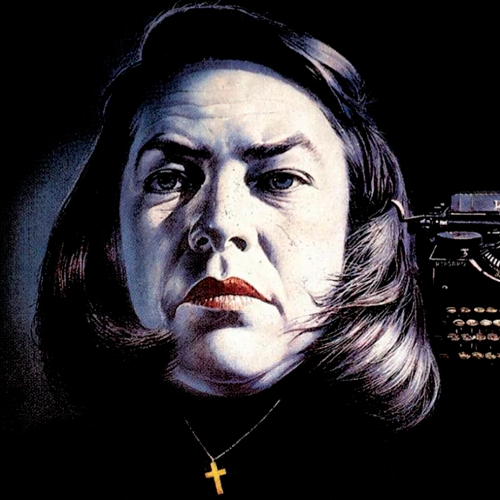

“Misery,” directed by Rob Reiner and released in 1990, is a psychological thriller based on Stephen King’s novel. The film tells the story of Paul Sheldon, a famous writer who, after a car accident, is rescued by a fan, Annie Wilkes. What starts as a seemingly benign gesture quickly turns into a nightmare when Paul discovers Annie’s unhealthy obsession with his book series.
The film explores complex themes such as obsession, isolation, and the thin line between adoration and possession. With standout performances by James Caan as Paul and Kathy Bates, who won an Oscar for her portrayal of Annie, “Misery” has become a landmark in psychological suspense cinema. Its tense plot and thrilling twists continue to captivate and disturb audiences today.
1 – THE ORIGINAL TEXT
According to King, his initial idea for writing Misery came after a nightmare while he was on a plane. In the dream, the author woke from a nap to find a woman beside him, speaking in a somewhat crazed voice: “I’m your number one fan!”
“Misery is a book about cocaine. Annie Wilkes is cocaine. She was my number one fan,” Stephen King said.
The author also claimed that Annie Wilkes was the personification of his drug addiction. In an interview with Rolling Stone, King stated, “Misery is a book about cocaine. Annie Wilkes is cocaine. She was my number one fan.” King struggled with substance abuse for years, and much of his work in the 1980s was written while he was under the influence.
2 – THE DIRECTION OF ROB REINER
“Misery was not the first time Reiner worked with a Stephen King work. In 1986, he directed the acclaimed film Stand by Me (based on the story ‘The Body’), which is highly cherished by King’s fans. Apparently, King was quite impressed with Reiner, to the point that when interest arose in acquiring the rights to Misery, King declared he would only sell if Reiner was the director or if his production company, Castle Rock Entertainment, was involved in the project.
Initially, the director assigned to the adaptation was George Roy Hill, but due to a disagreement with screenwriter William Goldman over the inclusion of the famous scene where the character Paul Sheldon has his foot struck by an axe (in the film, by a sledgehammer), Hill ended up leaving the project. Thus, Reiner took over the direction of Misery, as King had desired from the beginning.
To create the suspenseful atmosphere the film requires, Reiner revealed that he drew considerable inspiration from the work of Alfred Hitchcock. Considered one of the greatest masters of suspense, Hitchcock directed the film Rear Window (1954), in which the protagonist spends most of the time confined to a single setting, facing a situation beyond his control. In the hands of a talented filmmaker, this premise, which could be monotonous, transforms into an experience that heightens the audience’s torment.
3 – THE CAST
Today, it’s almost impossible to imagine “Misery” without Kathy Bates’s iconic performance as Annie Wilkes. Although other actresses have also brought the character to life excellently, such as Lizzy Caplan in Castle Rock and Mel Lisboa in the current Brazilian stage adaptation, in 1990, another actress was considered for the role. Bette Midler, who would later become known as one of the Sanderson sisters in Hocus Pocus (1993), was offered the role of Wilkes but found the story “too violent” and declined — something she later regretted.
Despite the offer to Midler, screenwriter William Goldman already had Kathy Bates in mind while writing the adaptation. At the time, Bates was better known for her theater work and had made a few appearances in TV series and films, but it was “Misery” and the Oscar she won for her portrayal of Annie Wilkes that propelled her career.
The casting of James Caan as Paul Sheldon was much more complicated. Names like Robert De Niro, Al Pacino, Dustin Hoffman, Harrison Ford, Richard Dreyfuss, Robert Redford, and Michael Douglas were considered, but all turned down the role. William Hurt was invited twice but also declined on both occasions.
Warren Beatty, known for films like “Bonnie and Clyde” (1967) and “Heaven Can Wait” (1978), expressed interest in playing Sheldon but had to drop out due to scheduling conflicts with the filming of “Dick Tracy” (1990).
4 – IMPORTANT NAMES IN HORROR
Some professionals involved in “Misery” later distinguished themselves in the horror film industry. For example, the film’s cinematographer, Barry Sonnenfeld, went on to direct the two “Addams Family” movies, which were major hits in the 1990s. Sonnenfeld also gained recognition for directing the “Men in Black” trilogy and for working on ten episodes of the series A Series of Unfortunate Events.
Kathy Bates, who starred in “Misery”, also took on other roles in the horror genre and related genres. Years later, she appeared in Misery’s sequel, another Stephen King adaptation, this time based on the book Dolores Claiborne. Additionally, Bates became a frequent presence in genre series.
On the other hand, some members of the Misery team already had established careers in horror, such as the KNB special effects team. Greg Nicotero and Robert Kurtzman worked diligently to make the iconic scene where Paul Sheldon’s foot is struck look as realistic as possible, using a mold very similar to James Caan’s leg. It is said that Kathy Bates was particularly sensitive during the filming of this scene. However, the result was a success, and the scene became one of the most memorable among King’s adaptations.
5 – BROADWAY ADAPTATION
William Goldman originally wrote the screenplay for Misery with a theatrical approach in mind — which may explain why he considered Kathy Bates so strongly for the role of Annie Wilkes, given her reputation as a respected theater actress. However, it would take a few years before the adaptation of Misery reached the Broadway stage.
The play was first presented in 2012 at the Bucks County Playhouse in New Hope, Pennsylvania, with Johanna Day as Wilkes and Daniel Gerroll as Paul Sheldon. In 2015, the production moved to Broadway at the Broadhurst Theatre, starring Laurie Metcalf as Wilkes and Bruce Willis as Sheldon, and ran until 2016. The following year, the play began to gain international recognition.
“Misery” is a film that stands out not only for its tense and engaging narrative but also for the numerous curiosities surrounding its production. From the adaptation of Stephen King’s novel to the casting choices and the challenges faced during filming, every detail has contributed to the film’s iconic status today.
Kathy Bates’s masterful performance, which earned her an Oscar, and Rob Reiner’s skillful direction turned Misery into a classic of psychological suspense. These curiosities only enrich the viewer’s experience, offering a new perspective on the creation of such a memorable work.








